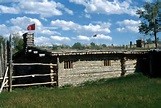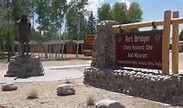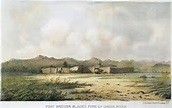Ft. Bridger, A Trading Post
Introduction
Text-to-speech Audio
Images
The historical Trading Post in Ft. Bridger

A back view of the Trading Post

The entrance to Ft. Bridger

An old western painting of Ft. Bridger

Backstory and Context
Text-to-speech Audio
The most notable historic resource in the Bridger Valley remains old Fort Bridger, now operated as a state historic site. Bridger and Vasquez established the fort on the Black’s Fork of the Green River and planned to trade both with the American Indians they had befriended during their years in the fur trade and the westward-bound emigrants. Their first "fort" consisted of two rude double-log houses about 40 feet in length, joined with a pen for horses. They also boasted a Blacksmith's shop, something that many emigrants welcomed after months on the trails.
But, for those emigrants who had long looked forward to their arrival at Fort Bridger, the post often turned out to be a disappointment. It was not nearly as well outfitted as the seemingly luxurious Fort Laramie on the eastern Wyoming plains. Fort Bridger turned out to be little more than a crude collection of rough-hewn log buildings. Emigrant Edwin Bryant said of the fort: "The buildings are two or three miserable cabins, rudely constructed and bearing but a faint resemblance to habitable houses.”
Jim Bridger. National Park Service.The Mormon Pioneer Company arrived at the fort on July 7, 1847. They spent a day there, but found all the prices very inflated. When a small group of Mormons settled nearby, tensions began to mount between Bridger and the new settlers. The settlers reported that Bridger was selling liquor and ammunition to the Indians, in violation of federal law.
Brigham Young, president of the Church of Jesus Christ of Latter-day
Saints, and a federal Indian agent, responded by sending the Mormon
militia to the fort in 1853. Bridger learned they were coming and fled
before the Mormons arrived. Later that year, the Mormons established
Fort Supply about twelve miles south of Fort Bridger, specifically to
service the Mormon emigrants.
